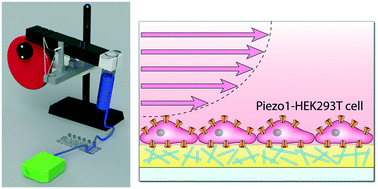Investigating the mechanotransduction of transient shear stress mediated by Piezo1 ion channel using a 3D printed dynamic gravity pump†
Abstract
Microfluidic systems are widely used for studying the mechanotransduction of flow-induced shear stress in mechanosensitive cells. However, these studies are generally performed under constant flow rates, mainly, due to the deficiency of existing pumps for generating transient flows. To address this limitation, we have developed a unique dynamic gravity pump to generate transient flows in microfluidics. The pump utilises a motorised 3D-printed cam–lever mechanism to change the inlet pressure of the system in repeated cycles. 3D printing technology facilitates the rapid and low-cost prototyping of the pump. Customised transient flow patterns can be generated by modulating the profile, size, and rotational speed of the cam, location of the hinge along the lever, and the height of the syringe. Using this unique dynamic gravity pump, we investigated the mechanotransduction of shear stress in HEK293 cells stably expressing Piezo1 mechanosensitive ion channel under transient flows. The controllable, simple, low-cost, compact, and modular design of the pump makes it suitable for studying the mechanobiology of shear sensitive cells under transient flows.

- This article is part of the themed collection: Lab on a Chip HOT Articles 2022


 Please wait while we load your content...
Please wait while we load your content...